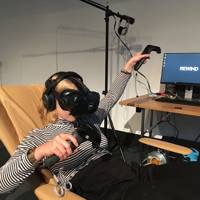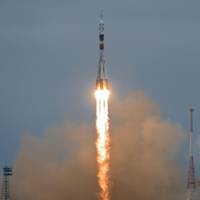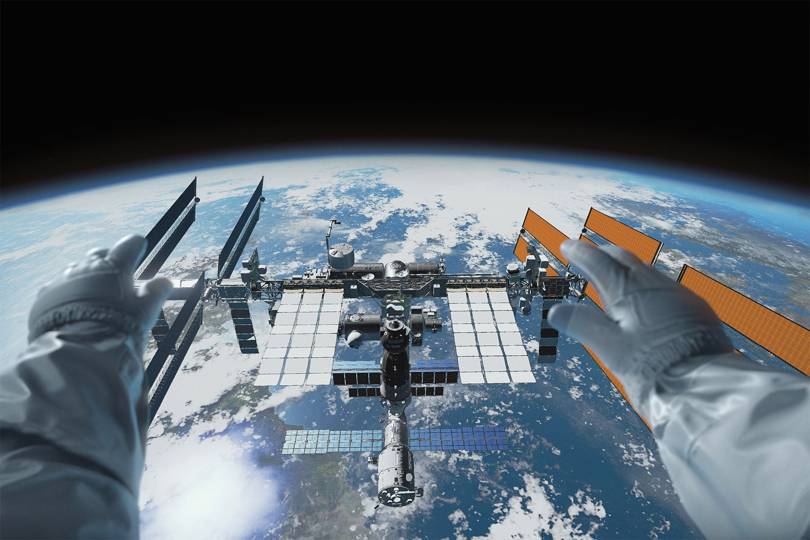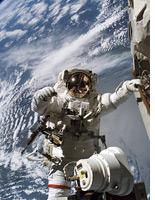Trio of new crew members successfully arrive at International Space Station

It’s been a number of months since the failed Soyuz launch derailed plans for astronaut Nick Hague and cosmonaut Alexey Ovchinin to head to the International Space Station, but they finally made it to their original destination. In a launch late Thursday, both Ovchinin and Hague headed to the ISS with first-time space traveler Christina Koch.
A few hours after launch, the Soyuz spacecraft carrying the trio docked with the space station, bringing the population of the ISS back up to its typical crew count of six. The newly-arrived scientists will spend roughly the next six months in space.
NASA is mighty happy to have its new astronauts aboard the space station, and provided a brief summary of the kinds of work the crew will be handling:
The crew members will spend more than six months conducting about 250 science investigations in fields such as biology, Earth science, human research, physical sciences, and technology development. Seventy-five of the investigations are new and have never been performed in space. Some of the investigations are sponsored by the U.S. National Laboratory on the space station, which Congress designated in 2005 to maximize its use for improving quality of life on Earth.
Being sent into space is something that only a very small percentage of humans have ever had the privilege of experiencing, but the crew of the ISS isn’t there for pleasure. Many of the experiments being conducted on the spacecraft provide useful information for scientific initiatives back on Earth, as well as future missions that will go deeper into space.
Later this month, new ISS inhabitant Christina Koch will be part of the first all-female spacewalk when she and fellow NASA astronaut Anne McClain step outside the ship to perform a variety of duties and experiments.

Astronaut team.
An astronaut space walk

Do Astronauts Have Sex?
In space, no one can hear you groan and moan.
Download the MP3 audio version of this story here, or sign up for My Blog: The Explainer’s free daily podcast on iTunes.

Astronaut.
Astronaut Lisa Nowak is facing attempted murder charges after she drove nearly 1,000 miles to confront a rival for the affections of another astronaut, Bill Oefelein. Nowak said that she and Oefelein had “more than a working relationship, but less than a romantic relationship.” Wait, did they ever get it on in space?
No. Nowak and Oefelein were never on the same mission, so they couldn’t possibly have joined the 62-mile-high club. But some of their colleagues may well have engaged in some extraterrestrial hanky-panky. Former and current astronauts don’t like to talk about space-shuttle sex, and NASA says that if it’s ever happened, the agency doesn’t know anything about it. (NASA has never conducted official experiments on animal reproduction in space, says a spokesman.)
If astronauts have had space sex, it would have been very difficult. First off, there isn’t much privacy up there. A regular shuttle is about as big as a 737, and the two main areas—the crew cabin and middeck and 'upper deck (lounge area)'—are each the size of a small office. The bathroom is little more than a seat with a curtain, and there aren’t any so called 'closed' rooms where two people could retreat, so they say. The space station, on the other hand, has a little more room to operate in. The three-person crew, per military training, generally splits up for sleeping time: Two of them bed down in a pair of tiny crew cabins at one end of the station, and the third might jump in a sleeping bag at the other end, almost 200 feet away. (The panel-and-strap design of a space bed might or might not be that conducive to lovemaking.) Astronauts also have a demanding work schedule, leaving them with little time or energy for messing around. Space-station crews do get time off on weekends, though, when they can watch movies, read books, play games, “and generally have a good time.”
Of course, speculation has been rampant. The first mission that included both men and women launched in 1982. But on that flight, cosmonaut Svetlana Savitskaya’s reputation for toughness, not to mention her married status, stamped out rumors. But they were travelling out side of earth. Folks travelling are free use at times, I've noticed in the military. The first married couple went to space in 1991, when training-camp and childhood, sweethearts Jan Davis and Mark Lee served together on a mission. NASA normally has a policy against letting married couples fly together, not because they’re afraid they’ll have sex, but because it might hurt the team dynamic. However, they made an exception for Davis and Lee since the couple got married so close to launch time. (In this photo, taken during the mission, Lee has his arm around Davis.) Both have refused to answer questions about the nature of their relationship during the mission. In the 1990s, rumors circulated about unorthodox coziness between Elena Kondakova and Valery Polyakov on a mission to the space station Mir, especially after a video got out showing Valery playfully splashing water on Elena during the flight.
The question of space sex has prompted at least one hoax. In his book The Last Mission, French author Pierre Kohler claimed that NASA had commissioned a study on sexual positions in outer space. He cited a fictional document, widely available online, that describes subjects experimenting with 10 different positions, six of which required an elastic band or sleeping-baglike tube to keep the couple together in zero gravity.
Which raises the question: Would space sex be any good? Recent research suggests it would not. For one thing, zero gravity can induce nausea—a less-than-promising sign for would-be lovers. Astronauts also perspire a lot in flight, meaning sex without gravity would likely be hot, wet, and surrounded by small droplets of sweat. In addition, people normally experience lower blood pressure in space, which means reduced blood flow, which means … well, you know what that means.
Albeit sex in space may not be safe.
Even in virtual reality, floating 402 kilometres (249.791 miles) above Earth is terrifying. Home, a 15-minute experience created by London-based production studio Rewind, is the closest most of us will get to the real thing.
We took a VR space walk on a £20,00 'weightlessness' chair0 in the name of tech journalism

Could you cut it as an astronaut? Try your hand at these real-life training scenarios


Astronaut team.
An astronaut space walk

Do Astronauts Have Sex?
In space, no one can hear you groan and moan.
Download the MP3 audio version of this story here, or sign up for My Blog: The Explainer’s free daily podcast on iTunes.

Astronaut.
Astronaut Lisa Nowak is facing attempted murder charges after she drove nearly 1,000 miles to confront a rival for the affections of another astronaut, Bill Oefelein. Nowak said that she and Oefelein had “more than a working relationship, but less than a romantic relationship.” Wait, did they ever get it on in space?
No. Nowak and Oefelein were never on the same mission, so they couldn’t possibly have joined the 62-mile-high club. But some of their colleagues may well have engaged in some extraterrestrial hanky-panky. Former and current astronauts don’t like to talk about space-shuttle sex, and NASA says that if it’s ever happened, the agency doesn’t know anything about it. (NASA has never conducted official experiments on animal reproduction in space, says a spokesman.)
If astronauts have had space sex, it would have been very difficult. First off, there isn’t much privacy up there. A regular shuttle is about as big as a 737, and the two main areas—the crew cabin and middeck and 'upper deck (lounge area)'—are each the size of a small office. The bathroom is little more than a seat with a curtain, and there aren’t any so called 'closed' rooms where two people could retreat, so they say. The space station, on the other hand, has a little more room to operate in. The three-person crew, per military training, generally splits up for sleeping time: Two of them bed down in a pair of tiny crew cabins at one end of the station, and the third might jump in a sleeping bag at the other end, almost 200 feet away. (The panel-and-strap design of a space bed might or might not be that conducive to lovemaking.) Astronauts also have a demanding work schedule, leaving them with little time or energy for messing around. Space-station crews do get time off on weekends, though, when they can watch movies, read books, play games, “and generally have a good time.”
Of course, speculation has been rampant. The first mission that included both men and women launched in 1982. But on that flight, cosmonaut Svetlana Savitskaya’s reputation for toughness, not to mention her married status, stamped out rumors. But they were travelling out side of earth. Folks travelling are free use at times, I've noticed in the military. The first married couple went to space in 1991, when training-camp and childhood, sweethearts Jan Davis and Mark Lee served together on a mission. NASA normally has a policy against letting married couples fly together, not because they’re afraid they’ll have sex, but because it might hurt the team dynamic. However, they made an exception for Davis and Lee since the couple got married so close to launch time. (In this photo, taken during the mission, Lee has his arm around Davis.) Both have refused to answer questions about the nature of their relationship during the mission. In the 1990s, rumors circulated about unorthodox coziness between Elena Kondakova and Valery Polyakov on a mission to the space station Mir, especially after a video got out showing Valery playfully splashing water on Elena during the flight.
The question of space sex has prompted at least one hoax. In his book The Last Mission, French author Pierre Kohler claimed that NASA had commissioned a study on sexual positions in outer space. He cited a fictional document, widely available online, that describes subjects experimenting with 10 different positions, six of which required an elastic band or sleeping-baglike tube to keep the couple together in zero gravity.
Which raises the question: Would space sex be any good? Recent research suggests it would not. For one thing, zero gravity can induce nausea—a less-than-promising sign for would-be lovers. Astronauts also perspire a lot in flight, meaning sex without gravity would likely be hot, wet, and surrounded by small droplets of sweat. In addition, people normally experience lower blood pressure in space, which means reduced blood flow, which means … well, you know what that means.
Albeit sex in space may not be safe.
Even in virtual reality, floating 402 kilometres (249.791 miles) above Earth is terrifying. Home, a 15-minute experience created by London-based production studio Rewind, is the closest most of us will get to the real thing.

Technology
We took a VR space walk on a £20,000 'weightlessness' chair in the name of tech journalism
Based on Tim Peake's NASA and European Space Agency (ESA) training programme, Rewind is intended as a re-creation of working and living on the International Space Station (ISS).
To develop the experience, the studio worked closely with NASA and the ESA. "NASA has an open-source library of 3D models and plans, so we used that for reference," explains Matt Allen, the company's 30-year-old CTO. "With the ISS model, the airlock and the suits, we wanted to be as accurate as possible." To build the visuals, the company used modelling packages such as 3D Studio Max and Unreal Engine 4.


The narrative, created by the BBC's digital storytelling team, begins on the Quest Airlock of the ISS.

Space
Could you cut it as an astronaut? Try your hand at these real-life training scenarios
After opening the airlock, players must traverse the exterior of the space station - with an accompanying view of Earth below - to a radiator panel. To do this they must use HTC Vive controllers as hands. The sensation is exhilarating, if at times unsettling: Allen's team had to adapt the experience because heights in VR can make viewers squeamish. "We had to tweak the way you move and traverse the outside of the ISS, taking away a few degrees of freedom," explains Allen. "It can be quite nauseating in VR."
Home won the Audience award at the Sheffield film festival in 2016 and is available now on HTC Vive and Oculus. Rewind may have traversed shallow space, but the studio isn't getting complacent. It is branching out into augmented reality with experiences using the Microsoft HoloLens. "VR is a major thing now," says Allen, "but we're always looking forward to the future." The sky's no longer the limit.







Comments
Post a Comment